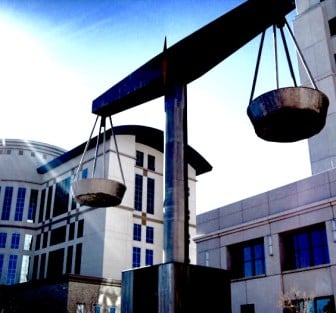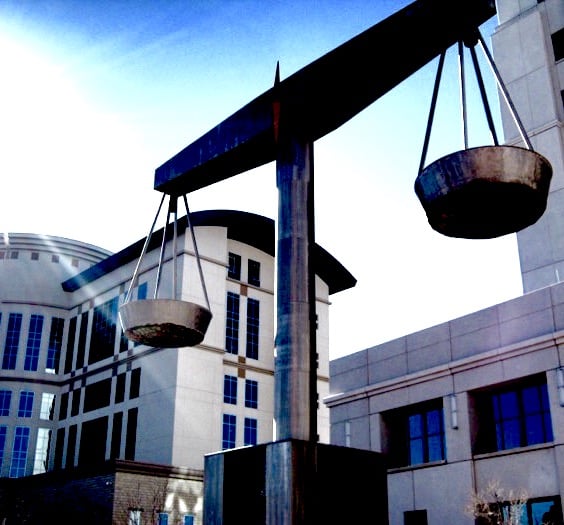 For 25 years, prosecutors in Bernalillo County used so-called “investigative grand juries” to review their decisions in police shooting cases. And for 25 years, people close to the process could not remember the controversial, since-discontinued panels coming to a different conclusion than the prosecutors who presented evidence to them: that the police shootings had been “justified” under New Mexico law.
For 25 years, prosecutors in Bernalillo County used so-called “investigative grand juries” to review their decisions in police shooting cases. And for 25 years, people close to the process could not remember the controversial, since-discontinued panels coming to a different conclusion than the prosecutors who presented evidence to them: that the police shootings had been “justified” under New Mexico law.
But 25 words in a newly unearthed court document from a 2011 grand jury show that there was at least one exception.
“That an agency outside of APD and another investigative grand jury review police procedures pertaining to the use of deadly force in officer involved shootings.”
That was the recommendation to prosecutors from the foreman for one of the grand juries on Dec. 16, 2011, after he and 11 others heard evidence from the June 2010 fatal shooting of Chris Hinz by two Albuquerque SWAT officers, Anthony Sedler and Eric Brown.
Unlike its predecessors — and unlike investigative grand juries used to review several more APD shootings after Hinz was killed — the grand jury did not rule the shooting justified. Nor did it determine the officers had been unjustified in shooting Hinz three times in Hinz’s Northeast Heights driveway. And the grand jury did not recommend charges be filed against Sedler or Brown. (Like its predecessors and successors, the panel was powerless to indict a police officer on its own, even if it had wanted to.)
By the time the panel heard evidence in the Hinz shooting, the investigative grand juries had become a source of controversy, with news stories publicizing that prosecutors had decided that police shootings were “justified” before they presented evidence to grand jurors.
The grand jury’s recommendation also foreshadowed the scrutiny that later would engulf APD surrounding its policies on use of deadly force. Nearly two-and-a-half years after the grand jury’s recommendation, the U.S. Department of Justice would issue a scorching review of the department’s use of force and leadership.
But it appears the grand jury’s recommendation, which was not disclosed publicly before today, went unheeded at the time.
District Attorney Kari Brandenburg said in an interview this morning that she recalled a case that ended with a grand jury recommendation for a review of APD policies. She did not recall the Hinz shooting case specifically.
Brandenburg told New Mexico In Depth she met with her top lieutenants, but the group determined that the DA’s office did not have the authority or the jurisdiction to do as the grand jury had asked “because they weren’t raising a concern of criminal wrongdoing.”
She did not recall seeking an outside agency to carry out the recommendation. Asked whether she discussed the grand jury’s finding with then-APD Chief Ray Schultz, Brandenburg said she did not recall a specific conversation.
“But we were talking about officer involved shootings at least monthly around that time period,” she said. “I would find it highly unusual if I did not discuss something like this with him … I might’ve said: ‘You know, chief, people are getting upset. Attitudes are starting to change. People are upset about procedures.’”
Schultz, who left APD at the end of 2013 and is now the assistant chief in Memorial Villages, Tex., has not returned a telephone message left for him this morning.
The grand jury from the Hinz shooting was attached to a civil rights lawsuit filed today against Sedler and others in connection with the fatal shooting of Jeremy Robertson in 2014.
The grand jury’s 2011 recommendation is significant for several reasons.
First, it represents the only known occasion in a quarter century that one of the investigative grand juries declined to rubber-stamp a decision by the Bernalillo County District Attorney’s Office in a police shooting case.
Second, because the panel’s recommendation appears not to have been followed, it stands as a missed opportunity for an outside review of APD at a time when the department was amassing a five-year total of police shootings that far outstripped the national average. For example: from 2010 through 2015, APD’s per capita rate of fatal police shootings was eight times that of the New York Police Department’s.
Third, it came during a time of increasing scrutiny of APD.
Family members of men shot by police and other APD critics had been packing the public comment sign-up sheet at City Council meetings for months to decry what they said was an out of control police force. Among their demands was a top-to-bottom investigation of the department.
Earlier in 2011, on June 8, a state District Court judge ruled in yet another civil rights case involving an APD shooting that the department’s training was “designed to result in the unreasonable use of deadly force.”
Later that month, a national law enforcement think tank issued the findings of its city-commissioned study of APD’s use of force. While the Police Executive Research Forum (PERF) did not go nearly as far as Judge Theresa Baca had, it did recommend changes for APD. The city made many of them, but some critics dismissed the PERF report as too closely directed by Mayor Richard Berry’s administration and pointed out that Schultz was a PERF board member at the time.
In August 2011, the City Council passed a resolution that would have invited the Justice Department to investigate APD. Berry vetoed the resolution. He later said it had procedural problems, including potential violations of the state Open Meetings Act. Councilors disputed the mayor’s contentions and called the veto an act of obstructionism.
Ultimately, the Justice Department did investigate Berry’s police department. In April 2014, federal authorities issued a damning set of findings: that APD had a deeply entrenched “culture of aggression” and its leaders had for years turned a blind eye to a broad pattern of excessive use of force.
It is unknown what would have happened had DA Brandenburg chosen to act on the grand jury’s recommendation after it reviewed the Hinz shooting.
“We just don’t have jurisdiction to look at procedures unless there’s a concern of criminal wrongdoing,” she told NMID. “That just isn’t our charge.”
During their investigation, DOJ officials looked at several of the same APD shootings grand jurors had considered and found that the majority of them violated the Constitution.
After a series of Albuquerque Journal stories in 2011 and 2012, state District Court judges ordered Brandenburg to stop using investigative grand juries to review police shootings. The grand jury presentations lacked impartiality, the judges said, and Brandenburg’s argument to continue using them was “legally fragile and unpersuasive.”
Brandenburg now posts her findings in police shootings online. Last year, she charged two APD officers with murder in the fatal shooting of James Boyd, a man who was living with mental illness and camping illegally in the Sandia Foothills. The officers are to stand trial later this year.
